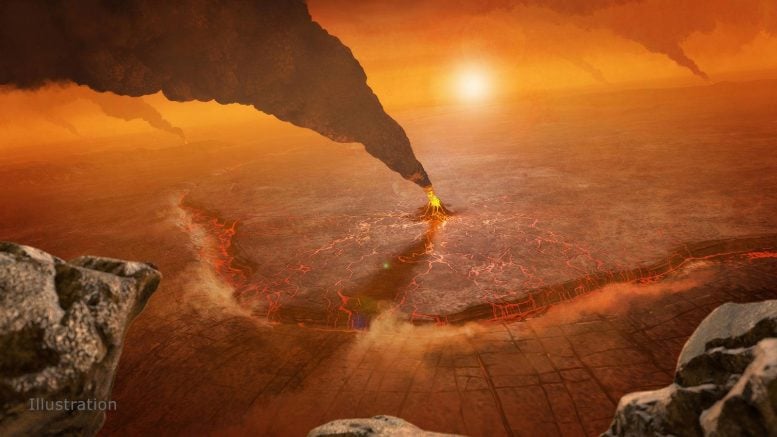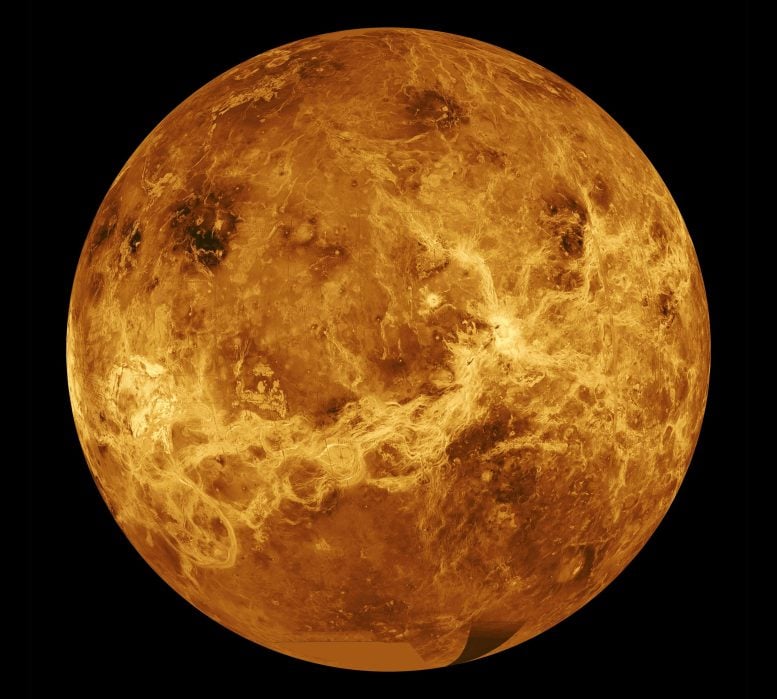
Venus may be far more geologically alive than anyone expected. New research suggests its outer crust could be churning with convection, a process that helps move heat and may explain the planet’s tens of thousands of volcanoes.
This overturns assumptions that crustal convection only happens deep in planetary interiors like Earth’s mantle. The findings offer a new lens on Venus’ evolution and hint at future missions that could map this activity. Even Pluto enters the picture, with strange surface patterns pointing to slow, icy tectonic movement driven by a similar mechanism.
Venus’ Fiery Surface May Be More Active Than Thought
Venus, a scorching planet covered in tens of thousands of volcanoes, may be more geologically active near its surface than scientists once believed. Researchers at Washington University in St. Louis have run new calculations suggesting that Venus’ outer crust could be continuously churning through a process known as convection. This surprising possibility may help explain the planet’s extensive volcanic activity and other surface features.
“Nobody had really considered the possibility of convection in the crust of Venus before,” said Slava Solomatov, a professor of earth, environmental and planetary sciences in Arts & Sciences. “Our calculations suggest that convection is possible and perhaps likely. If true, it gives us new insight into the evolution of the planet.”
The study, co-authored by postdoctoral researcher Chhavi Jain, was published in Physics of the Earth and Planetary Interiors.

Familiar Process, Unfamiliar Location
In geology, convection refers to the movement of heated material rising while cooler material sinks, creating a continuous cycle, much like a conveyor belt. On Earth, this process occurs deep in the mantle and is the driving force behind plate tectonics.
Earth’s crust, about 40 kilometers (~25 miles) thick in continents and 6 km (~4 miles) in ocean basins, is too thin and cool to support convection, Solomatov explained. But he suspected the crust of Venus might have the right thickness (perhaps 30-90 km, depending on location), temperature, and rock composition to keep that conveyor belt running.
New Theories, New Possibilities
To check that possibility, Solomatov and Jain applied new fluid dynamic theories developed in their lab. Their calculations suggested that Venus’ crust could, in fact, support convection — a whole new way to think about the geology of the planet’s surface.
In 2024, the two researchers used a similar approach to determine that convection likely does not happen in the mantle of Mercury because that planet is too small and has cooled significantly since its formation 4.5 billion years ago.

Extreme Heat and the Search for a Heat Transfer Mechanism
Venus, on the other hand, is a hot planet both inside and out. Surface temperatures reach 870 degrees Fahrenheit, and its volcanoes and other surface features show clear signs of melting. Scientists have long wondered how heat from the planet’s interior could be transferred to the surface. “Convection in the crust could be a key missing mechanism,” Solomatov said.
Convection near the surface also could influence the type and placement of volcanoes on the Venusian surface, Solomatov said. In 2023, Paul Byrne, an associate professor of earth, environmental, and planetary sciences in Arts & Sciences, published an atlas of 85,000 Venus volcanoes based on radar images from NASA’s Magellan mission from the early 1990s. Solomatov said he and Byrne have discussed possible future collaborations that would combine mathematical modeling with observations of Venus’ surface for a better understanding of the planet’s geology.
What Future Missions Could Reveal
Solomatov hopes future missions to Venus could provide even more detailed data on the density and temperature in the crust. If convection is occurring as expected, some areas of the crust should be warmer and less dense than others, differences that would be detectable using high-resolution gravity measurements.
But perhaps an even more intriguing target is Pluto, the frozen dwarf planet at the outer reaches of the solar system. Images from the New Horizons mission revealed remarkable polygonal patterns on Pluto’s Sputnik Planitia region that resemble plate boundaries on Earth. These polygons are formed by slow convection currents in a 4 km-thick layer of solid nitrogen ice. “Pluto is probably only the second planetary body in the solar system, other than Earth, where convection that drives tectonics is clearly visible on the surface,” Solomatov said. “It’s a fascinating system that we still need to figure out.”
Reference: “On the possibility of convection in the Venusian crust” by Viatcheslav S. Solomatov and Chhavi Jain, 21 February 2025, Physics of the Earth and Planetary Interiors.
DOI: 10.1016/j.pepi.2025.107332
Never miss a breakthrough: Join the SciTechDaily newsletter.
2 Comments
I find S.T.Daily to be well written. I will read more of these articles.
“We evaluate the possibility of convection in the Venusian crust by utilizing recently developed scaling laws for the onset of convection in temperature- and stress-dependent viscosity fluids, heated from below or from within.
Interesting, but it hinges on their new proposed scaling laws.